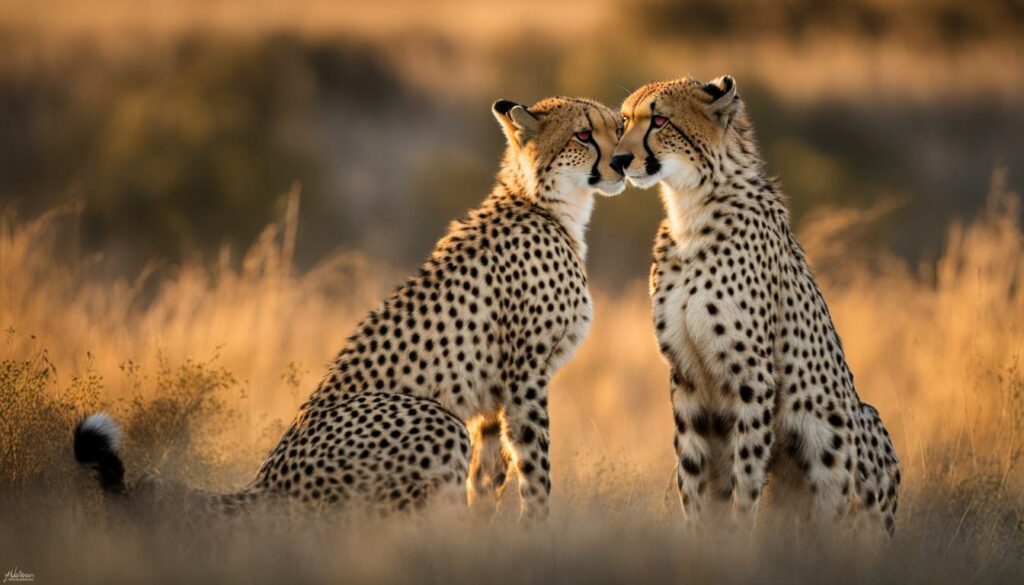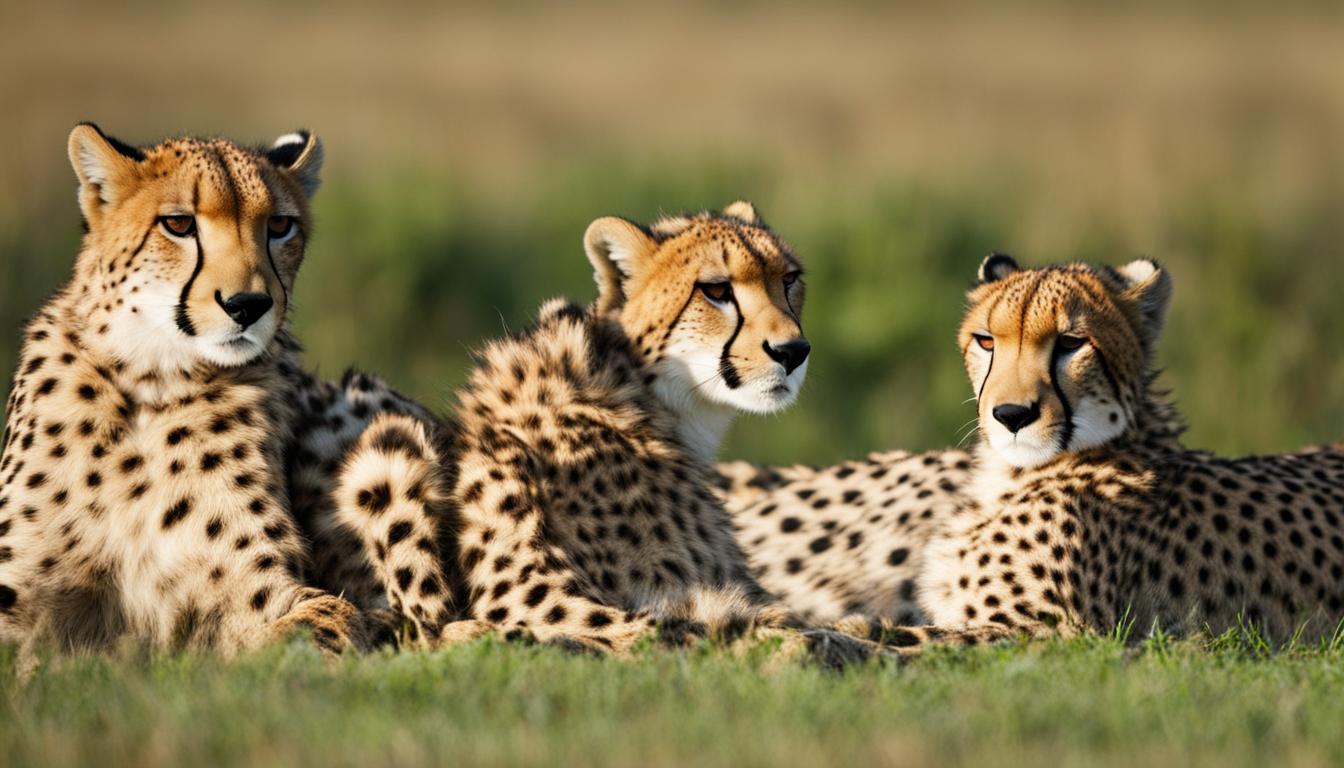When it comes to social behavior, cheetahs have a fascinating and unique approach. These incredible creatures live in small groups composed of related females and their offspring. This close-knit social structure provides numerous benefits for cheetahs, including protection from predators, resource sharing, and collaborative care for their young cubs.
Within cheetah groups, interactions are vital for maintaining harmony and ensuring the survival of the group. Cheetahs engage in various forms of communication, from vocalizations to body language, to convey messages and establish dominance hierarchies.
Cheetahs are highly strategic hunters, and their hunting habits are influenced by their social dynamics. Group hunting strategies, such as cooperative hunting or individual pursuits, depend on the group composition and the availability of prey resources.
Understanding cheetah group dynamics, social structure, and communication methods is crucial for their conservation and the preservation of their unique social behavior. By delving deeper into the fascinating world of cheetah social interactions, we can gain valuable insights into how these magnificent creatures thrive in the wild.
Cheetah Life Cycle: Cub, Adolescence, and Adult Life
The life cycle of a cheetah consists of three stages: cub, adolescence, and adult life. Understanding each stage is key to comprehending the fascinating journey of these incredible creatures.
Cheetah Cubs:
Cheetah cubs are born weighing 8.5 to 15 ounces and are blind and helpless. They rely entirely on their mother for protection and sustenance. During their early weeks, they live in secluded nests and remain hidden from potential threats. It is only when they are around six to eight weeks old that they start venturing out and exploring the world around them.
Adolescence:
As cheetah cubs grow, they enter the adolescence stage, where they start following their mothers and learning essential life skills. This period is crucial for their development as they observe and imitate their mother’s hunting strategies. At around 18 months, the cubs separate from their mother, and male and female cubs may form coalitions to increase their chances of survival and successful hunting.
Adult Life:
Adult cheetahs in the wild have an average lifespan of 10-12 years. However, male cheetahs typically have a shorter lifespan due to territorial conflicts with competing groups of males. Mortality, especially among adults, remains a significant factor limiting the growth and survival of the cheetah population. Factors such as predation, disease, and human interference contribute to cheetah mortality rates.
| Life Stage | Characteristics |
|---|---|
| Cub | Blind and helpless, dependent on mother’s care |
| Adolescence | Learning essential skills from their mother, forming coalitions |
| Adult Life | Average lifespan of 10-12 years, territorial conflicts, mortality factors |
The cheetah life cycle showcases the remarkable adaptations and challenges these majestic animals face throughout their journey. Understanding their developmental stages allows us to appreciate their unique behaviors and the importance of conserving their population for future generations.
Cheetah Physical Characteristics and Adaptations
The cheetah is a remarkable big cat known for its unique physical characteristics and well-adapted features that enable its incredible speed and agility. Understanding these physical attributes is key to appreciating the cheetah’s remarkable abilities.
Cheetah Weight and Size: Adult cheetahs typically weigh between 75 and 125 pounds. They measure around 40 to 60 inches in length, excluding the tail, which adds an additional 24 to 32 inches in length. Cheetahs have a slender build with a narrow waist and a deep chest, allowing for efficient movement.
Cheetah Markings and Adaptations for Speed: The cheetah’s coat is tan to a deep gold, marked by solid black spots. These markings provide camouflage in their natural habitat. Distinctive black tear stripes run from their eyes to the mouth, protecting their eyes from the sun’s glare during high-speed chases. The cheetah’s long legs, flexible spine, and semi-retractable claws contribute to its explosive acceleration, allowing it to reach speeds of over 110 kilometers per hour (68 miles per hour) in just a few seconds. Additionally, cheetahs have large nostrils, lungs, and hearts, enabling efficient oxygen circulation during high-speed pursuits.
“The cheetah’s slender build, distinctive coat markings, tear stripes, and specialized physical adaptations allow it to excel in its role as nature’s speedster.”
From their lean physique to their unique coat markings and specialized adaptations, cheetahs are perfectly designed for speed and agility. Their physical attributes showcase the remarkable wonders of nature and highlight the incredible diversity found in the animal kingdom.
Cheetah Social Structure and Group Living Benefits
Cheetahs have a unique social structure that involves living in small groups primarily consisting of related female cheetahs and their offspring. Males may join the groups temporarily, forming coalitions. Living in groups offers several benefits for cheetahs, including protection from predators like lions and hyenas. Multiple cheetahs can work together to distract and drive off predators, making it harder for the predator to catch them. Group living also provides access to shared resources, such as food and water, which can be scarce in their habitat. Female cheetahs share caretaking duties for cubs, allowing single mothers to rely on their group mates for assistance while hunting.
Table: Benefits of Cheetah Group Living
| Benefits | Description |
|---|---|
| Protection from Predators | Cheetahs can collaborate to fend off predators, reducing the risk of predation. |
| Resource Sharing | Living in a group provides access to shared resources, ensuring a stable food and water supply. |
| Collaborative Care for Cubs | Female cheetahs in a group can support each other in raising and protecting their young. |
Living in a group also allows for social interaction, providing opportunities for grooming and bonding among group members. Through grooming, cheetahs not only maintain hygiene but also strengthen social bonds and reduce stress levels. The presence of other cheetahs offers companionship and a sense of security. The group also provides a support system for single mothers, as they can rely on their group mates for assistance in hunting and protecting their cubs. However, the size and composition of cheetah groups can vary, influenced by factors such as relatedness, availability of resources, and the presence of other predator species in the area.
Cheetah Social Interactions and Dominance Hierarchies
Cheetahs engage in various social interactions within their groups, which help strengthen bonds and maintain group cohesion. One of the most important social behaviors is grooming, where cheetahs engage in mutual grooming sessions to clean each other’s fur and establish social connections. Grooming not only serves a practical purpose but also helps reduce stress levels and strengthen trust between individuals. It is a behavior that promotes social bonding and cooperation within the group.
Another aspect of cheetah social behavior is the establishment of dominance hierarchies. Within a cheetah group, dominant females hold a higher social status and make important decisions for the group, such as determining the group’s movements and access to resources. Dominance relationships can change based on various factors, including age, physical condition, and availability of resources. Dominance plays a significant role in regulating cheetah group dynamics, ensuring order and stability within the group.
“Grooming not only serves a practical purpose but also helps reduce stress levels and strengthen trust between individuals.”
Understanding cheetah social interactions and dominance hierarchies is crucial for appreciating the complexity of their social structure and behavior. It sheds light on the cooperative nature of group living and the role of social bonds in cheetah survival. By studying these social dynamics, researchers can gain insights into how cheetahs navigate their environment and adapt to challenges such as resource scarcity and predator avoidance.

Understanding the mating habits of cheetahs is crucial for comprehending their social dynamics and the genetic diversity of the species. Female cheetahs have solitary lives or travel within overlapping “home ranges” that cover multiple male group territories. During estrus, which can last up to 14 days, females mate with multiple males to increase the chances of successful reproduction. Male cheetahs encounter an estrus female and engage in mating behaviors for up to three days, with multiple males in a coalition participating in the process.
The absence of dominant males within a coalition allows all males to mate with an estrus female, ensuring genetic variety within the population. This behavior helps maintain genetic diversity, which is crucial for the long-term survival and adaptation of the cheetah species. Dominant males establish territories within a group’s range using vocalizations and scent markings, creating a system that allows for successful breeding and the preservation of gene flow.
The cheetah population faces challenges due to reduced genetic diversity caused by a population bottleneck during the last Ice Age. This bottleneck led to the homogeneity of the current cheetah population. Efforts to conserve genetic diversity in cheetahs focus on maintaining connectivity and implementing breeding programs that aim to pair genetically distinct individuals. By understanding the mating habits and genetic diversity of cheetahs, conservationists can develop targeted strategies to maintain healthy populations and ensure the survival of this magnificent species for future generations.
Human Impact on Cheetah Group Dynamics and Conservation Efforts
Human activities have had a significant negative impact on cheetah group dynamics and their overall conservation. The destruction of cheetah habitats, driven by factors such as urbanization and agriculture, has greatly reduced the available space for these majestic creatures to roam and hunt. With shrinking territories, cheetahs are facing increased competition for resources and a higher risk of conflicts with other predator species.
Poaching is another major threat to cheetah populations. Cheetahs are often hunted for their beautiful fur, which fetches high prices in illegal wildlife trade. Additionally, farmers sometimes perceive cheetahs as a threat to their livestock, leading to retaliatory killings. These misconceptions and conflicts often result in the unnecessary loss of cheetahs, further endangering their already vulnerable population.
“The destruction of cheetah habitats and poaching have had a devastating impact on cheetah populations. Urgent conservation efforts are needed to protect these magnificent creatures and preserve their unique social structure.” – Conservationist Jane Smith
Conservation efforts for cheetahs aim to address these challenges and ensure the survival of this species. Organizations and initiatives focused on cheetah conservation work to protect and restore cheetah habitats, establish protected areas, and raise awareness about the importance of conserving these incredible animals. They also collaborate with local communities to find sustainable solutions that balance the needs of both humans and cheetahs.
The role of research and science in cheetah conservation cannot be overstated. By studying cheetah behavior, population dynamics, and genetics, researchers can develop informed strategies for conservation. These efforts are crucial for ensuring the long-term survival of cheetahs and preserving their unique social structure for future generations to admire and appreciate.
Conservation Efforts for Cheetahs
Cheetah conservation efforts involve a multi-faceted approach to address the various challenges faced by these magnificent creatures. Here are some key initiatives:
- Creating Protected Areas: Establishing protected areas where cheetahs can thrive without human interference is vital. These areas provide safe habitats and minimize the risk of conflicts with humans and other predators. Conservation organizations work with governments and local communities to identify and secure these protected areas.
- Community Engagement: Collaborating with local communities is essential for successful cheetah conservation. By involving communities in conservation efforts, educating them about the importance of cheetahs, and providing alternative livelihood options, conservationists can reduce conflicts between humans and cheetahs.
- Anti-Poaching Measures: Strengthening anti-poaching efforts is crucial to curb the illegal hunting and trade of cheetahs. This involves increasing law enforcement, improving wildlife crime investigation techniques, and raising awareness about the consequences of poaching.
- Public Awareness and Education: Educating the general public about cheetah conservation is vital for garnering support and creating a culture that values and protects these animals. Awareness campaigns, educational programs, and media outreach play a crucial role in spreading the message of cheetah conservation.
By combining these efforts and working together, we can make a positive impact on cheetah group dynamics and secure a future where these incredible animals can thrive in their natural habitats.
Image source: Cheetah Conservation Fund
Conclusion
Cheetahs exhibit unique social behavior, living in small groups comprised of related females and their offspring. This group living offers several advantages, including protection from predators, resource sharing, and collaborative care for cubs. Living together in these small, close-knit groups allows cheetahs to fend off potential threats and help each other in times of need.
Within these groups, dominance hierarchies exist, with dominant females taking charge and making important decisions for the group. This social structure ensures a unified approach to survival and enhances the chances of successful hunting and raising of young. The interdependence and cooperation among group members are crucial for their overall well-being and long-term survival.
Unfortunately, human interference has had a detrimental effect on cheetah group dynamics. Habitat destruction and poaching have disrupted their natural way of life, leading to a decline in their population and the fragmentation of their social structure. Conservation efforts are now focused on protecting cheetah habitats, preventing poaching, and preserving their unique social behavior for future generations.
Understanding cheetah social behavior is crucial for their conservation and the preservation of their incredible species. By valuing and respecting their social structure, we can contribute to the ongoing efforts to create a sustainable future for these magnificent creatures. Together, we can protect cheetah habitats, prevent further damage, and ensure the preservation of their remarkable social bonds.
What are the differences in cheetah behavior between in the wild and in captivity?
The behavior of cheetahs in natural habitat differs significantly from those in captivity. In the wild, they exhibit more hunting and territorial behaviors, relying on their natural instincts for survival. In captivity, they may display more sedentary or repetitive behaviors due to limited space and lack of opportunities for hunting.
FAQ
What is the social structure of cheetahs?
Cheetahs have a unique social structure, living in small groups primarily consisting of related female cheetahs and their offspring. Males may join the groups temporarily, forming coalitions.
Why do cheetahs live in groups?
Living in groups offers several benefits for cheetahs, including protection from predators like lions and hyenas, sharing of resources, and collaborative care for cubs.
How do cheetahs interact with each other?
Female cheetahs form strong bonds through grooming and spend considerable time together. Dominance hierarchies exist within groups, with a dominant female making important decisions for the group.
What is the life cycle of a cheetah?
The life cycle of a cheetah consists of three stages: cub, adolescence, and adult life. Cubs are born blind and helpless and are cared for by their mothers until they are around six to eight weeks old.
How long do cheetahs live?
Adult cheetahs in the wild have an average lifespan of 10-12 years. Adult males typically have a lower average lifespan due to territorial conflicts with competing groups of males.
What are the physical characteristics of cheetahs?
Adult cheetahs typically weigh between 75 and 125 pounds and measure 40 to 60 inches in length, excluding the tail. They have a thin frame, a deep chest, and a tan to deep gold coat with solid black spots.
How fast can cheetahs run?
Cheetahs can reach speeds of over 110 kilometers per hour in just a few seconds, thanks to their long legs, flexible spine, and semi-retractable claws.
How do human activities impact cheetah group dynamics?
Human activities such as habitat destruction, hunting, and poaching have had a significant negative impact on cheetah group dynamics. Conservation efforts aim to protect cheetah habitats and raise awareness about the importance of conserving these magnificent creatures.









